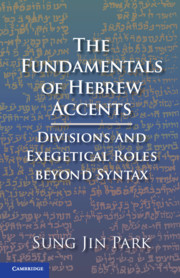Book contents
- The Fundamentals of Hebrew Accents
- The Fundamentals of Hebrew Accents
- Copyright page
- Dedication
- Contents
- Tables
- Preface
- Abbreviations
- 1 Introduction to Tiberian Hebrew Accents
- 2 Major Rules of Hebrew Accents
- 3 Substitutions of Disjunctive Accents (I)
- 4 Substitutions of Disjunctive Accents (II)
- 5 Conjunctive Accents
- 6 Minor Rules of Hebrew Accents
- 7 The Divisions by Hebrew Accents
- 8 The Exegetical Roles of the Divisions
- Book part
- Bibliography
- Subject Index
- Scripture Index
7 - The Divisions by Hebrew Accents
Published online by Cambridge University Press: 27 June 2020
- The Fundamentals of Hebrew Accents
- The Fundamentals of Hebrew Accents
- Copyright page
- Dedication
- Contents
- Tables
- Preface
- Abbreviations
- 1 Introduction to Tiberian Hebrew Accents
- 2 Major Rules of Hebrew Accents
- 3 Substitutions of Disjunctive Accents (I)
- 4 Substitutions of Disjunctive Accents (II)
- 5 Conjunctive Accents
- 6 Minor Rules of Hebrew Accents
- 7 The Divisions by Hebrew Accents
- 8 The Exegetical Roles of the Divisions
- Book part
- Bibliography
- Subject Index
- Scripture Index
Summary
Chapter Seven discusses scholars’ long-standing debates about what the divisions marked by the disjunctive accents represent linguistically. They offer at least three primary suggestions, all of which have validity: 1) to mark stress, 2) to provide musical notations, and 3) to express syntax. Thus, the linguistic representation of the divisions marked by the disjunctive accents is examined from the word level through the sentence level and some related topics, specifically prosodic analysis of the accentual divisions and performance structure are also discussed. This chapter demonstrates that the divisions marked by the Tiberian accents correspond with prosodic divisions and suggested three criteria for delimitation: 1) major disjunctive accents (Silluq, Athnach, Little Zaqeph, Rebia, and rarely Segolta) function as major delimiters, 2) final disjunctives have no dividing force, and 3) a disjunctive accent on the initial word in a phrase or a sentence does not have dividing force. Notably, these accentual divisions correspond with performance structure in light of pausal duration on speech. This shows that the primary purpose of the accents is to mark the proper recitation of the text.
Keywords
- Type
- Chapter
- Information
- The Fundamentals of Hebrew AccentsDivisions and Exegetical Roles beyond Syntax, pp. 93 - 115Publisher: Cambridge University PressPrint publication year: 2020



